You'll need proper equipment and careful temperature control to safely preserve sauces outdoors. For solar processing, use dark-colored containers and maintain temperatures above 82°C (180°F), while fire pit methods require positioning 10-20 feet from structures with proper safety measures. Verify your containers are heat-resistant and suitable for temperatures up to 190°C (374°F). Store processed sauces in airtight containers away from direct sunlight and monitor for any signs of spoilage. Always follow safe handling practices and quality assurance steps for peak results. Understanding the complete preservation process can make the difference between success and spoilage.
Outdoor Heat Processing Equipment
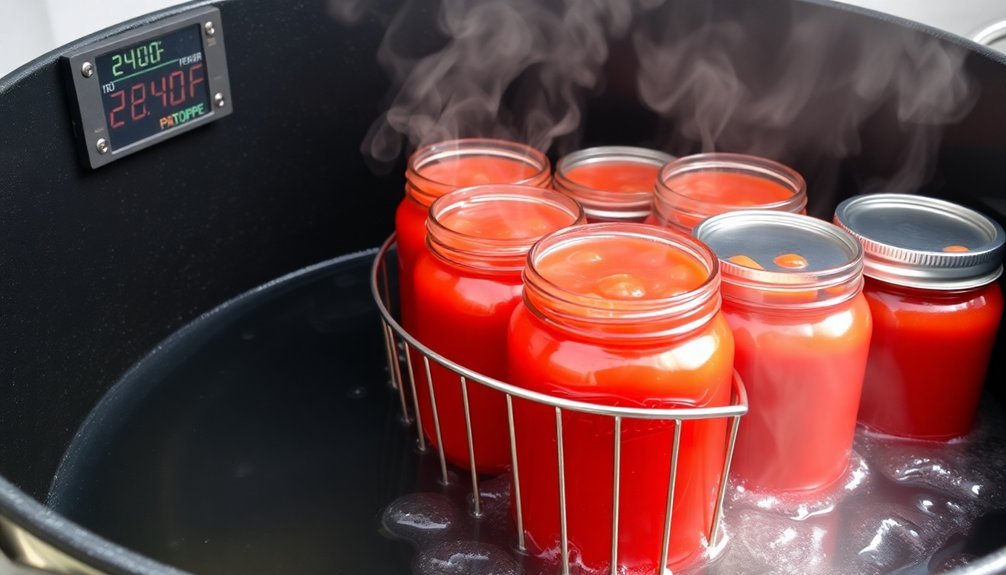
Massive industrial ovens and nimble solar cookers represent opposite ends of the outdoor heat processing spectrum.
You'll find industrial options like conveyor and batch ovens that can handle extreme temperatures up to 2,200°F, using specialized alloys like RA330 and HR-120® for maximum thermal efficiency. With over 20 years of experience, HeatTek has perfected these industrial oven designs for optimal performance.
For a sustainable alternative, you can build a solar oven using basic materials like cardboard, aluminum foil, and glass.
These eco-friendly units can reach temperatures up to 300°F, making them suitable for slow thermal processing.
When you need supplementary heat, patio heaters offer versatile solutions through freestanding or mounted units with infrared heating systems.
Each option brings distinct advantages: industrial systems provide precise control and high-volume capacity, solar ovens offer sustainability, and patio heaters deliver spot heating flexibility.
Solar Cooking Temperature Control
While achieving consistent temperatures in solar cooking requires attention to detail, you can maintain reliable heat levels through strategic design and positioning.
For ideal sauce preservation, you'll need to monitor internal temperatures closely with a thermometer, ensuring they reach at least 82°C for safe processing.
To maintain stable temperatures for sauce preservation:
- Pre-heat your solar cooker for 15-20 minutes before adding your sauce containers.
- Use dark, lidded cookware to maximize heat absorption and retention.
- Position a thick metal plate at the bottom of your cooker for improved heat distribution.
- Adjust the cooker's position throughout the day to follow the sun's path.
For best results, you'll want to choose a clear day and set up in a location that's protected from wind, as weather conditions can greatly impact your temperature control. To prevent food spoilage, always use a dark-colored metal dish for optimal heat absorption during the preservation process.
Sterilization Methods
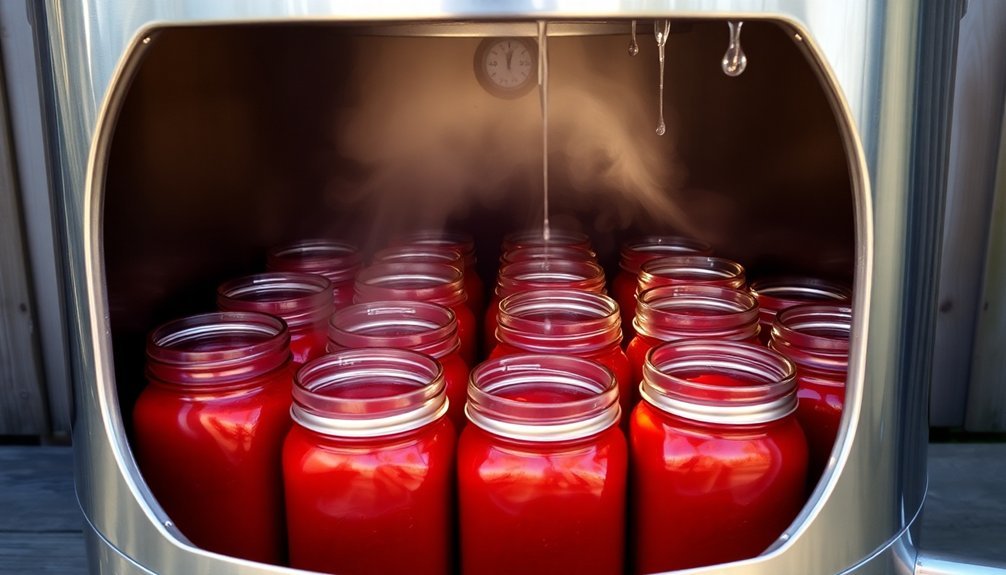
Proper sterilization serves as the cornerstone of safe sauce preservation, requiring precise temperature control and timing to eliminate harmful microorganisms.
You'll need to heat your sauces above 100°C (212°F), typically between 110-125°C, depending on their acidity and container size.
When sterilizing your sauces, you'll have to take into account the equilibration time needed for heat to penetrate evenly throughout the container.
The process involves three key stages: initial heating, holding at the target temperature, and controlled cooling. This comprehensive approach ensures commercial sterility for safe distribution and extended shelf life.
You can use various equipment like retorts, water baths, or autoclaves, depending on your sauce type and volume.
Remember to adjust your processing time based on altitude, container material, and the sauce's physical properties.
For example, thicker sauces require longer processing times to make sure heat reaches their center effectively.
Safe Handling Practices
Safe handling of sauces requires four essential practices: maintaining proper storage temperatures, using clean utensils, monitoring for spoilage, and following correct heating procedures.
You'll need to store unopened jars in a cool, dark place and keep opened ones in the refrigerator below 40°F (4°C).
When handling your sauce, follow these critical steps:
- Use clean utensils every time you serve or scoop sauce to prevent contamination.
- Check for unusual odors, mold, or color changes before using stored sauce.
- Heat expired sauce to a rolling boil (165°F/74°C) for at least 2 minutes.
- Transfer sauce to an airtight container that matches the remaining volume if the original jar is damaged.
Always stir sauce frequently while heating to guarantee even temperature distribution and avoid storing it near direct sunlight or heat sources.
Proper Container Selection
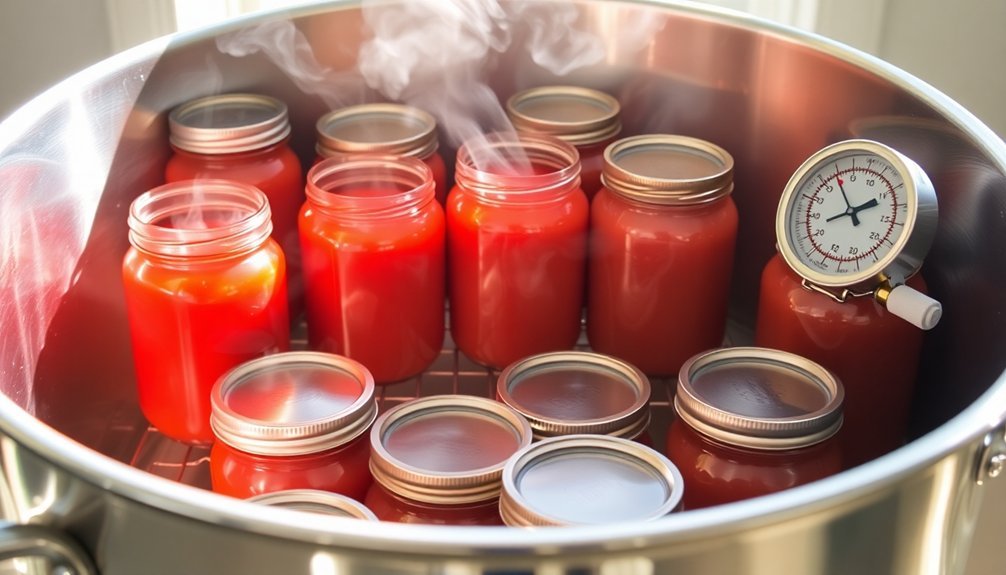
Beyond safe handling practices, selecting the right container for your sauce makes a significant difference in its preservation.
You'll want to focus on heat-resistant materials that can withstand temperatures up to 190 degrees Celsius during the filling process.
Glass containers, particularly Mason jars with their two-piece lid system, are excellent choices as they're reusable and can handle high temperatures without deforming.
If you're considering plastic, look for heat-set PET or HDPE options specifically designed for hot filling. While these might cost more initially, they're engineered to maintain their integrity during heat processing.
Remember to check that your chosen containers are compatible with your filling equipment and sterilization methods.
For sustainability and cost savings, consider glass jars that you can sterilize and reuse multiple times.
Moisture Control Techniques
Controlling moisture in your sauces presents one of the most critical challenges in preservation. You'll need to actively manage water content to prevent spoilage and extend shelf life. Using humectants like glucose syrup or sorbitol can effectively bind water without affecting taste considerably.
To maintain proper moisture control in your sauces:
- Add precise amounts of salt or sugar to bind water molecules and inhibit microbial growth.
- Process filled jars at 90.5°C minimum, ensuring proper headspace for expansion.
- Remove air bubbles before sealing to prevent moisture accumulation.
- Consider dehydrating sauces completely for shelf-stable products.
Remember to check regularly for moisture contamination and keep your sauces between 3°C and 23°C during storage.
If you're freezing sauces, maintain temperatures below -4°C to stop microorganism growth completely.
Natural Heat Source Setup
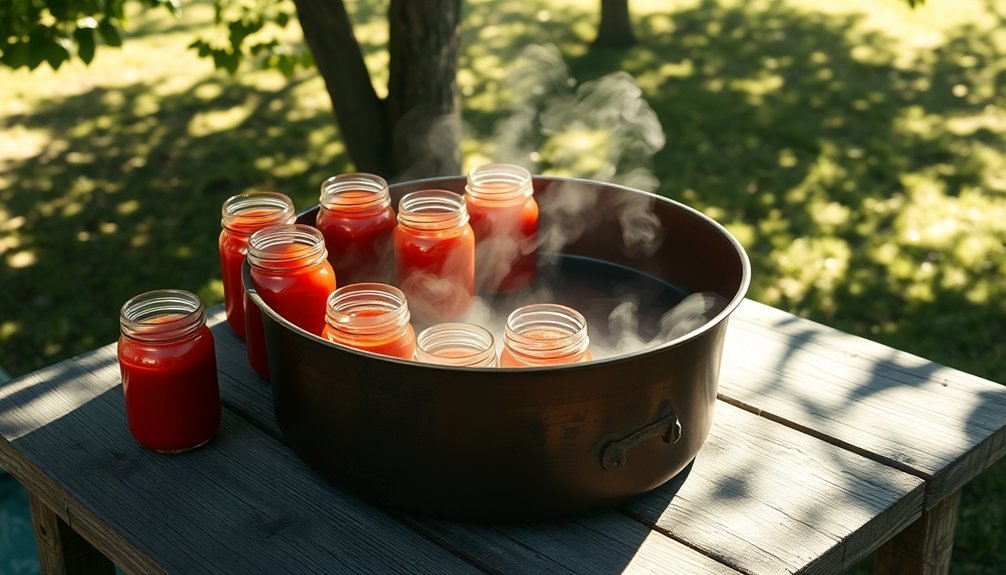
When setting up your natural heat sources for sauce preservation, you'll need a well-constructed fire pit with properly placed stones and adequate distance from flammable materials for safety.
You can maximize your preservation options by positioning a solar heating station nearby, using solar ovens and dehydrators for daytime processing while maintaining the fire pit for evening work.
Set up your equipment so you can easily monitor both heat sources, keeping the solar station in direct sunlight and the fire pit in a ventilated area with easy access to your preserving supplies.
Fire Pit Safety Basics
Setting up a safe fire pit requires four essential considerations: proper placement, fuel selection, safety equipment, and constant supervision.
You'll need to position your fire pit 10-20 feet from structures on level ground, guaranteeing there's no overhead interference from branches or power lines.
For safe outdoor sauce preservation, follow these critical fire pit guidelines:
- Choose a fire-resistant base using materials like concrete pavers, gravel, or sand.
- Burn only seasoned hardwood or softwood, avoiding treated lumber or household waste.
- Keep safety equipment nearby, including a fire extinguisher, water source, and metal ash bucket.
- Monitor wind conditions and maintain constant supervision until the fire is completely extinguished.
Always douse flames thoroughly with water, stirring ashes to ascertain all embers are cold before disposal.
Check the pit again the following day for lingering heat.
Solar Heating Station Setup
To preserve sauces using solar energy, you'll need a properly configured heating station that harnesses natural sunlight. Position your solar panels and reflective surfaces to maximize sun exposure, and guarantee your setup includes proper insulation to maintain consistent temperatures.
| Component | Purpose |
|---|---|
| Solar Panels | Convert sunlight to power heating elements |
| Generator | Store energy for cloudy periods |
| Vacuum Tubes | Capture and retain solar heat |
| Temperature Gauge | Monitor heating consistency |
| Insulation | Maintain stable temperatures |
You'll want to use a hybrid model that can switch to electrical power when sunlight is insufficient. Consider portable units like the GoSun Fusion or BLUETTI power stations for flexibility. Clean your equipment immediately after use to maintain efficiency, and always position your station where it'll receive ideal sunlight throughout the preservation process.
Quality Assurance Steps
Successful sauce preservation requires a thorough quality assurance program that covers business compliance, testing protocols, and safety measures.
You'll need to register with the FDA and maintain detailed records of your compliance activities while sourcing ingredients from approved suppliers.
To guarantee your sauce meets safety standards, follow these essential steps:
- Test pH levels regularly, aiming for 4.6 or below for BBQ sauce, and record all readings on designated logs.
- Partner with third-party labs to verify nutritional content and guarantee accurate labeling.
- Monitor temperatures throughout production and implement immediate corrective actions if critical limits aren't met.
- Store ingredients in food-grade containers with tight-fitting lids, keeping them separated to prevent cross-contamination.
Always cool your sauce to room temperature before bottling and maintain proper sanitation protocols throughout the process.
Processing Time Guidelines
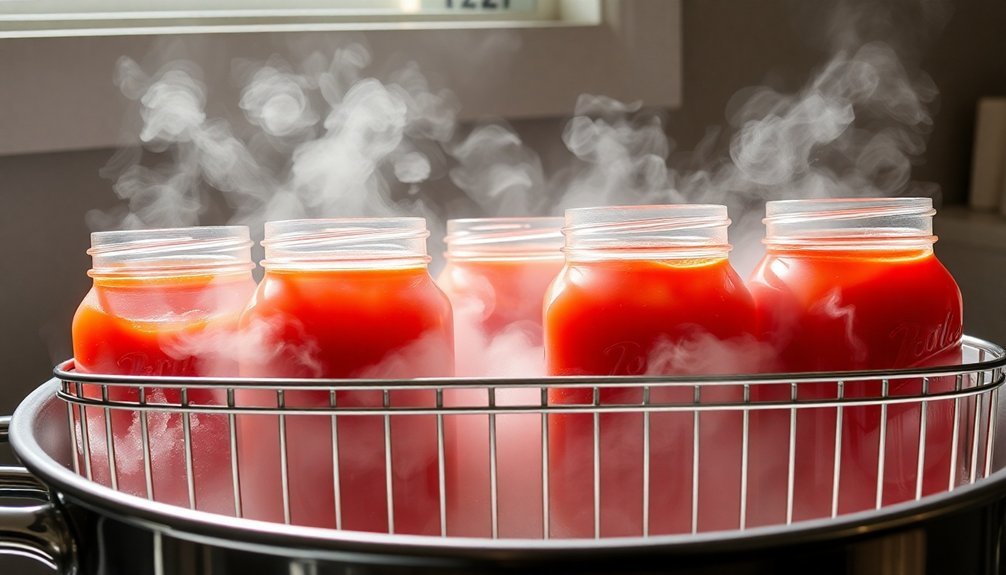
Since sauce processing times vary markedly by altitude and preservation method, understanding the correct duration for your location is essential. You'll need to adjust your processing times based on your elevation, whether you're using a boiling water bath or pressure canner.
| Elevation (ft) | Water Bath Time (Pints) | Pressure (lb) |
|---|---|---|
| 0-1,000 | 35 minutes | 6 |
| 1,001-3,000 | 40 minutes | 6 |
| 3,001-6,000 | 45 minutes | 8 |
| 6,000+ | 50 minutes | 9 |
| BBQ Sauce | -5 minutes from above | Not recommended |
For specialty sauces like BBQ or hot sauce, you'll use shorter processing times. Hot sauce requires just 10-20 minutes depending on altitude. Remember to let your jars rest in the water for an additional 5 minutes after processing, regardless of the method you've chosen.
Sunlight Exposure Management
You'll need to schedule your sauce processing during non-peak sun hours, typically before 10 AM or after 4 PM, to minimize UV exposure.
During processing, keep your sauce containers in shaded areas or under UV-protective coverings to prevent quality degradation and bacterial growth.
If you're working in an area with intense sunlight, consider using amber-colored containers or UV-protective wraps to shield your sauces from harmful rays.
Peak Sun Hours Matter
Understanding peak sun hours is critical for effective sauce preservation through solar drying. You'll achieve the best results when you work with nature's ideal conditions, targeting temperatures above 85°F with humidity below 60%.
To maximize your sauce preservation efforts, you'll need to align your processing time with the sun's most potent hours.
- Position your drying racks in south-facing locations where you'll get unobstructed sunlight exposure.
- Use reflective surfaces to boost sun exposure by up to 25%, especially during morning and late afternoon hours.
- Monitor UV levels with a meter to determine the most efficient drying periods.
- Adjust your setup by rotating racks to follow the sun's movement, ensuring consistent heat exposure.
Keep your sauces covered with high-temperature bags or plastic wrap to maintain steady heat distribution throughout the drying process.
Shade During Processing Time
While proper sunlight exposure is essential for sauce preservation, managing shade during processing helps maintain consistent quality and protects your workspace.
You'll need to set up shade structures when temperatures exceed 80°F, ensuring they're as close as possible to your processing area. Use portable canopies, umbrellas, or tarpaulins to create adequate coverage for all workers.
If you've got mature trees with thick canopies or suitable buildings nearby, these can serve as natural shade sources.
Make sure your shade setup allows for proper air circulation and wind flow, which is vital for both worker comfort and sauce processing conditions.
Position chairs or benches in the shaded area, and assign someone to monitor temperatures hourly.
When planning your processing schedule, check weather forecasts to anticipate high-heat days and prepare shade structures accordingly.
UV Protection Guidelines
Since direct sunlight plays an essential role in sauce preservation, proper UV protection measures must be implemented to guarantee both product quality and worker safety.
When processing sauces outdoors, you'll need to balance effective sun exposure with UV protection strategies.
- Schedule your processing activities outside peak UV hours (10am-4pm) whenever possible, or use partial shade structures to reduce direct exposure.
- Provide workers with protective gear including wide-brimmed hats, long-sleeved shirts, and UV-blocking sunglasses.
- Set up your drying stations in areas with good airflow and temperatures above 85°F (29°C), while maintaining humidity below 60%.
- Monitor weather conditions continuously and adjust your setup if UV intensity increases unexpectedly.
Don't forget to apply sunscreen regularly and reposition shade structures as the sun moves throughout the day.
Storage After Processing
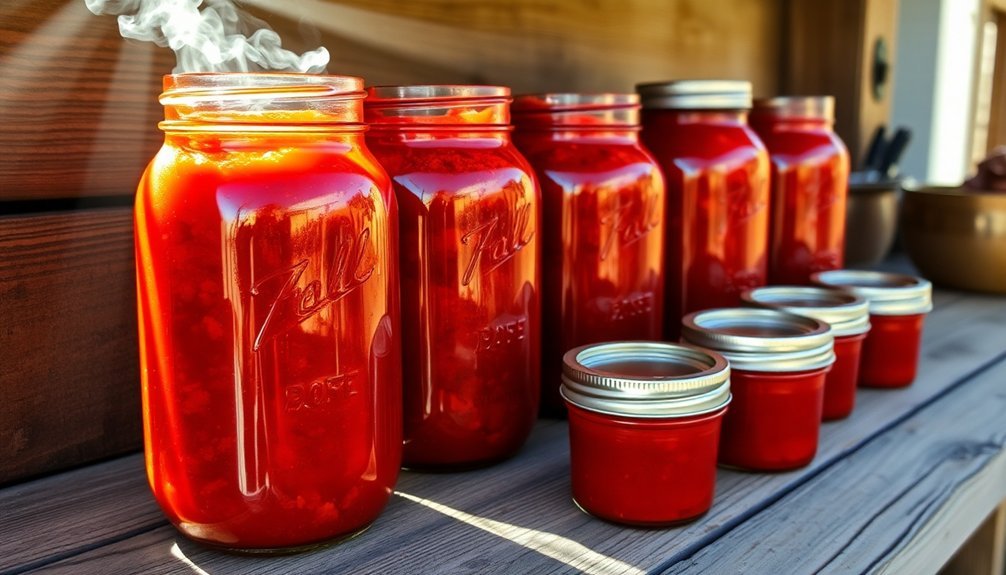
Once you've processed your sauces, proper storage becomes essential for maintaining their quality and safety.
Store them in clean, airtight glass containers with tight-fitting lids to prevent contamination and preserve freshness. You'll need to keep them away from direct sunlight to avoid degradation.
While hot sauces can stay at room temperature due to their high vinegar content, you'll extend their shelf life by refrigerating them.
Different sauces have varying storage needs – BBQ sauce lasts 6-9 months, while salsa needs refrigeration after a month.
Remember to maintain a consistent refrigerator temperature and keep your storage area clean.
Watch for signs of spoilage like mold, unusual odors, or discoloration.
Always check the "best by" dates and note that opened containers won't last as long as sealed ones.
Weather Considerations
Weather plays a significant role in sauce preservation success, especially when processing outdoors. You'll need to monitor environmental conditions carefully and adjust your process accordingly. Temperature fluctuations, altitude, and humidity can all impact your results.
Before starting your outdoor canning session, consider these critical factors:
- Check the weather forecast and plan for a day with stable temperatures and minimal precipitation.
- If you're at a high altitude, increase your processing time to compensate for the lower boiling point.
- Set up your workspace in a sheltered area to protect against wind and direct sunlight.
- Monitor humidity levels, as excessive moisture can interfere with proper jar sealing.
You'll achieve better results by working during mild weather conditions and avoiding extreme temperatures or precipitation that could compromise your preservation efforts.
Sanitization Guidelines
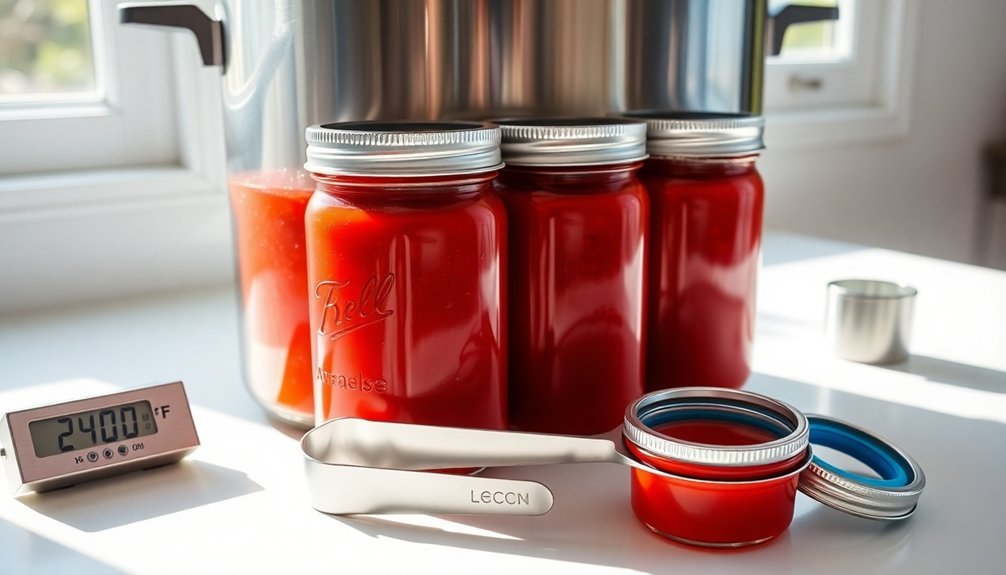
Proper sanitization serves as the cornerstone of safe sauce preservation, protecting your products from harmful bacteria and contamination.
You'll need to clean and disinfect your pump system regularly, and always use dry, clean spoons when handling sauces.
Sterilize your jars at 150°C for 20 minutes after washing them in warm soapy water. When filling hot sauce, keep the jars hot and maintain proper headspace: 7mm for jams and 12mm for tomatoes.
Don't overfill, as this can compromise the lid's seal.
Remember to wash your hands thoroughly before handling sauces, and wear gloves if needed.
Keep your storage area clean and moisture-free. You'll want to avoid direct sunlight and maintain consistent temperatures using ice in containers when necessary.
These practices will help guarantee your sauces remain safe and stable.
Frequently Asked Questions
Can Different Types of Sauces Be Processed Together in the Same Batch?
You shouldn't process different sauces together since they require specific heat treatments based on their viscosity, acidity, and composition. Each sauce type needs unique processing times and equipment for ideal results.
How Do Insects and Wildlife Affect Outdoor Sauce Processing?
You'll need to protect your sauce from insects contaminating ingredients and wildlife disturbing equipment. They're attracted to food odors, so you should use sealed containers and protective barriers during outdoor processing.
What Emergency Backup Methods Exist if Outdoor Processing Is Interrupted?
You can quickly switch to indoor methods like stovetop simmering or pressure cooking. If that's not possible, refrigerate your sauce immediately, use vacuum sealing, or freeze it in airtight containers for later processing.
Does Altitude Affect Outdoor Processing Differently Than Indoor Processing Methods?
You'll face the same altitude challenges whether cooking indoors or outdoors, but outdoor processing needs extra monitoring since wind and temperature variations can further affect boiling points and evaporation rates.
Can Traditional Indigenous Preservation Techniques Be Incorporated Into Modern Outdoor Processing?
You can effectively incorporate Indigenous drying, smoking, and fermenting techniques into modern processing. You'll find these methods are sustainable, culturally rich, and work well alongside contemporary practices for preserving your foods outdoors.
In Summary
You'll find that successful outdoor sauce preservation combines proper equipment selection, careful temperature monitoring, and strict sanitization practices. By managing sunlight exposure and weather conditions while following safe handling protocols, you're ensuring your sauces remain shelf-stable. Remember to choose appropriate containers and maintain consistent sterilization standards. When done correctly, outdoor heat processing offers an eco-friendly preservation method for your homemade sauces.

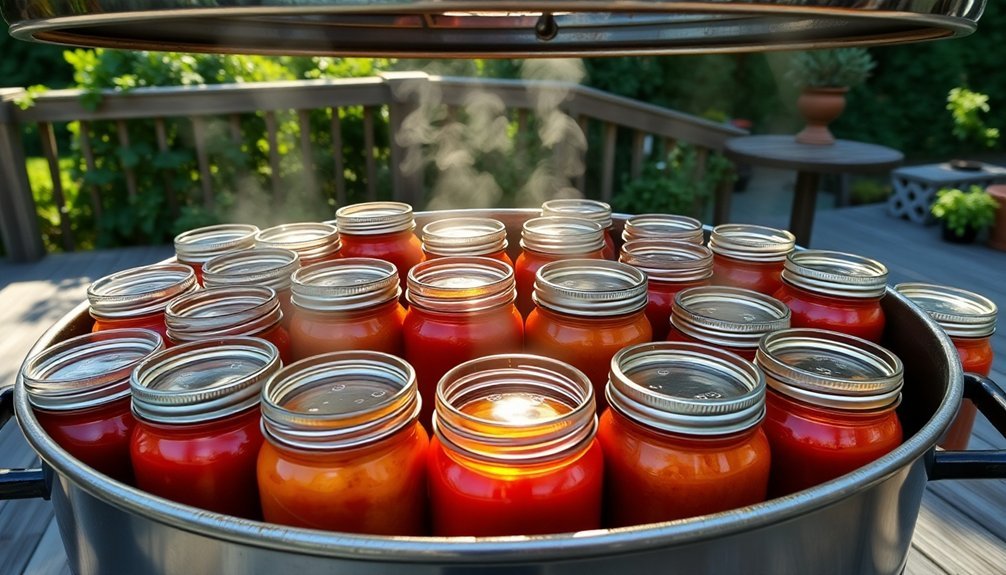



Leave a Reply